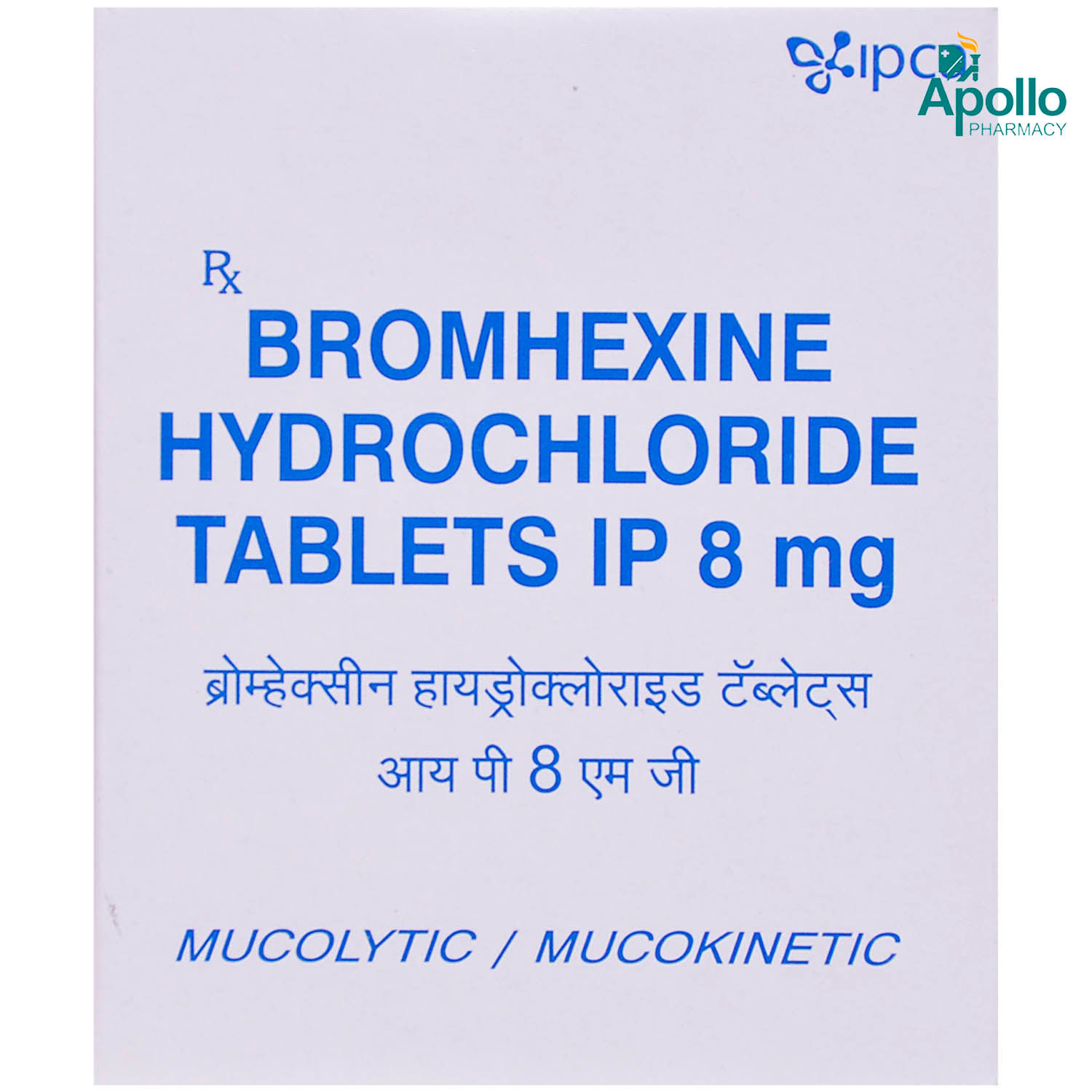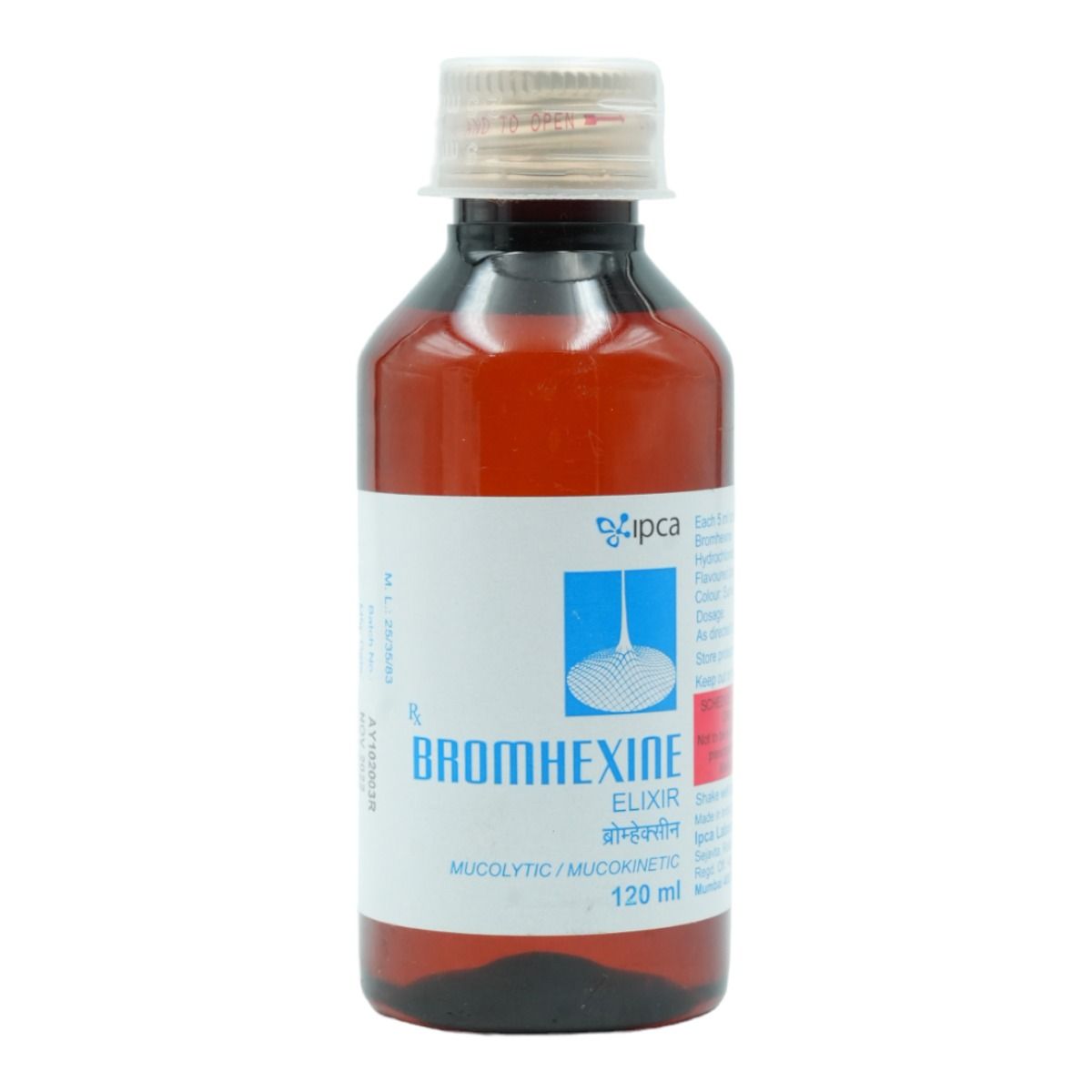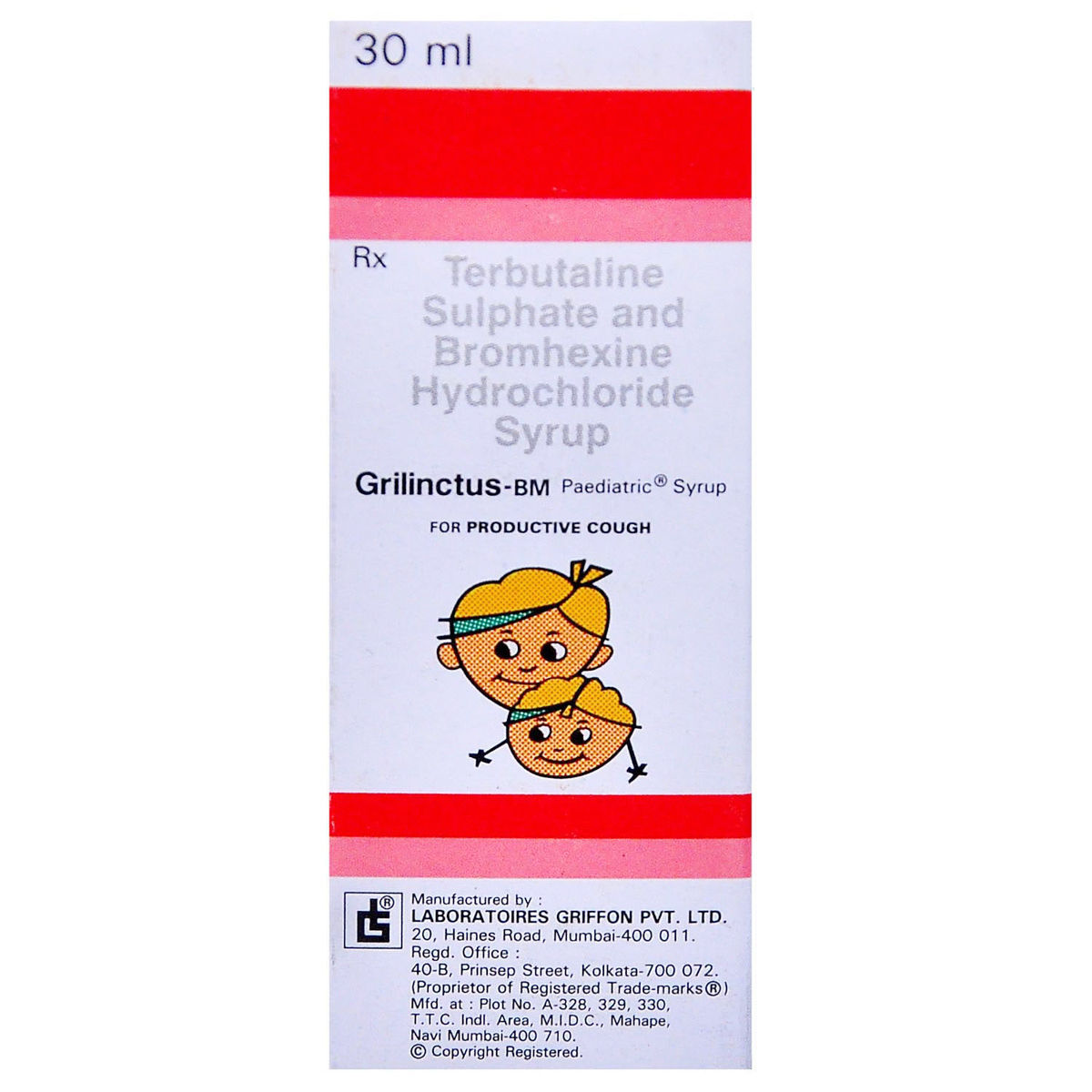Bromhexine
About Bromhexine
Bromhexine belongs to the class of medicines called 'expectorants' primarily used to treat cough associated with mucus. Coughing (dry or productive) is the body's way of clearing irritants (like allergens, mucus, or smoke) from airways and preventing infection. There are two types of coughs: Dry cough and chesty cough. A dry cough is tickly and doesn't produce any vicious or thick mucus, while a chesty cough (wet cough) means mucous or sputum is produced to help clear your airways.
The Bromhexine contains bromhexine. It enhances mucus transport by reducing mucus viscosity and activating the ciliated epithelium (mucociliary clearance). This secretolytic and secretomotor effect in the bronchial tract area relieves cough and facilitates expectoration.
Your doctor will recommend how often you take Bromhexine based on your medical condition. Some people may experience nausea, vomiting, drowsiness, headache, dizziness, skin rash, stomach upset, and diarrhoea. Most of these side effects of Bromhexine do not require medical attention and gradually resolve over time. However, if the side effects persist or worsen, please consult your doctor.
Please tell your doctor if you are allergic to Bromhexine or any other medicines. If you are pregnant or breastfeeding, it is advised to inform your doctor before using Bromhexine. Bromhexine should be used with caution in children below six years. Drink plenty of fluids while taking Bromhexine to loosen mucus. If you have stomach ulcers, asthma, phenylketonuria (a congenital disability that causes accumulation of amino acid, phenylalanine in the body), or kidney or liver problems, inform your doctor before taking Bromhexine.
Uses of Bromhexine
Medicinal Benefits
Bromhexine contains Bromhexine. Bromhexine is used in a condition where there is a lot of thick mucus in the airways. It enhances mucus transport by reducing mucus viscosity and by activating the ciliated epithelium (mucociliary clearance). This secretolytic and secretomotor effect in the bronchial tract area relieves cough and facilitates expectoration.
Directions for Use
Storage
Side Effects of Bromhexine
- Nausea
- Vomiting
- Diarrhoea
- Upper abdominal pain
- Sweating
- Angioedema
- Urticaria
- Bronchospasm
- Headache
- Dizziness
- Rash
- Pruritus
Drug Warnings
Do not take Bromhexine if you are allergic to any components present in Bromhexine. If you are pregnant or breastfeeding, it is advised to inform your doctor before using the Bromhexine. Bromhexine should be used with caution in children below six years. Drink plenty of fluids while taking Bromhexine to loosen mucus. If you have stomach ulcers, asthma, phenylketonuria (a congenital disability that causes accumulation of amino acid, phenylalanine in the body), or kidney or liver problems, inform your doctor before taking the Bromhexine.
Drug Interactions
Drug-Drug Interactions: Bromhexine may interact with antibiotics (e.g., erythromycin, cefalexine, ampicillin, amoxicillin, oxytetracycline), non-steroidal anti-inflammatory medicines (e.g., phenylbutazone and oxyphenbutazone).
Drug-Food Interactions: Avoid dairy products such as milk, which may increase mucus production. Also, avoid processed or refined foods to relieve cough.
Drug-Disease Interactions: If you have stomach ulcers, asthma, phenylketonuria (a birth defect that causes the accumulation of the amino acid phenylalanine in the body), or kidney or liver problems, inform your doctor before taking Bromhexine.
Drug-Drug Interactions Checker List:
Safety Advice

Alcohol
unsafeAvoid consumption of alcohol with Bromhexine as it may increase drowsiness. Please consult a doctor before consuming alcohol with Bromhexine.

Pregnancy
consult your doctorThe safety of Bromhexine in pregnant women is unknown. Therefore, it is given to pregnant women only if the doctor thinks the benefits outweigh the risks.

Breast Feeding
consult your doctorIt is unknown whether Bromhexine is excreted in human milk. Bromhexine is given to breastfeeding mothers only if the doctor thinks the benefits outweigh the risks.

Driving
cautionBromhexine may cause dizziness or drowsiness in some people. Therefore, drive only if you are alert after taking the Bromhexine.

Liver
cautionTake Bromhexine with caution, especially if you have a history of Liver diseases or conditions. Your doctor may adjust the dose as needed.

Kidney
cautionTake Bromhexine with caution, especially if you have a history of Kidney diseases or conditions. Your doctor may adjust the dose as needed.

Children
cautionBromhexine should be used with caution in children if prescribed by a doctor. Your doctor may adjust the dose as required.
Habit Forming
Diet & Lifestyle Advise
- Avoid dairy products such as milk, as they may increase mucus production. Also, avoid processed or refined foods to relieve cough. Instead, replace baked foods, fried foods, white bread, white pasta, French fries, sugary desserts, and chips with green leafy vegetables.
- Drink plenty of fluids to avoid dry throat while you have a cough and loosen mucus.
- Avoid citrus fruits as they may worsen the cough.
- Eat fruits rich in water content, such as pears, watermelon, peaches, and pineapples.
- Eat a healthy diet and exercise regularly to strengthen your breathing muscles and boost your immune system.
- Learning breathing exercises will help you move more air in and out of your lungs.
- Quit smoking and avoid passive smoking. Smoking also reduces the effectiveness of the medicine.
Special Advise
- You are recommended to inform your doctor that you are taking Bromhexine before undergoing any medical tests or surgery.
- If your cough persists for more than one week, stop using Bromhexine and consult your doctor.
- Do not take Bromhexine if you have taken an MAO inhibitor (anti-depressant medication) in the past 14 days, and it may cause serious drug interaction.
Patients Concern
Disease/Condition Glossary
Cough: Coughing is the body’s way of clearing irritants (like allergens, mucus, or smoke) from airways and preventing infection. Coughs may be dry or productive. A productive cough (wet cough) brings up sputum (phlegm, mucus, and other matter) from the lungs. Cough is commonly caused as a response to allergy or viral infection but coughing up mucus is possibly an indication of infection in the respiratory tract. If you are coughing thick, solid white mucus, it indicates you may have a bacterial infection in the airways. If the mucus is clear or light-coloured, it indicates you may have allergies or a minor infection in the respiratory tract, and yellow or green mucus indicates a respiratory infection.
FAQs
Bromhexine is used to treat cough associated with mucus.
Bromhexine contains Bromhexine, a mucolytic medication that thins and loosens mucus (phlegm) in the nose, windpipe, and lungs, making coughing easier.
It is not recommended to stop taking Bromhexine without consulting your doctor, as it may worsen your cough or cause recurring symptoms. Therefore, take Bromhexine for as long as your doctor has prescribed it, and if you experience any difficulty while taking it, please consult your doctor.
There is a sugar-free syrup available for diabetes patients. It is always better to consult a doctor before using Bromhexine if you have diabetes.
No, Bromhexine is not recommended for patients suffering from stomach ulcers, which may worsen the condition. However, please consult a doctor before taking Bromhexine.
Before taking Bromhexine, inform the doctor if you have a chronic cough, stomach ulcers or cough due to asthma, smoking, emphysema or chronic bronchitis.
Thinning of mucus is an indication that Bromhexine is working. It helps thin the mucus and facilitates its removal from the airways.
Bromhexine may be effective in preventing symptomatic COVID. However, please consult the doctor if you have COVID or any concerns regarding this.
Bromhexine may not be suitable for dry cough as it is indicated in the treatment of cough associated with mucus. Consult the doctor if you have dry cough; the doctor will prescribe appropriate medicine based on your condition.
Yes, Bromhexine may cause drowsiness or dizziness in some cases. Do not drive or operate machinery unless you are alert.
Other cough syrups may interfere with the working of Bromhexine. Therefore, avoid using other cough syrups while taking Bromhexine unless advised by the doctor.
Though no interactions have been found between Bromhexine and paracetamol, both medicines should be taken together only if advised by the doctor. However, consult the doctor if you have any concerns.
Drinking enough fluids helps loosen mucus. Hence, you can drink water after taking Bromhexine.
Drinking enough fluids, using a humidifier, avoiding alcohol & caffeine, using a warm compress, and gargling with salt water can help provide relief from congestion.
Yes, a prescription is required to purchase Bromhexine. The doctor will prescribe Bromhexine after evaluating your condition.
Bromhexine should be used during pregnancy or breastfeeding only if advised by the doctor. Please consult the doctor if you are pregnant, think you may be pregnant or breastfeeding.
Bromhexine may cause side effects like nausea, vomiting, drowsiness, headache, dizziness, skin rash, stomach upset, and diarrhoea. Most of these side effects of Bromhexine do not require medical attention and gradually resolve over time. However, if the side effects persist or worsen, please consult your doctor.
Bromhexine should be used with caution in children and only if prescribed by the doctor. Please consult the doctor if you have any concerns regarding the usage of Bromhexine in children.
Store Bromhexine at room temperature, in a dry place. Keep it out of sight and reach of children.









